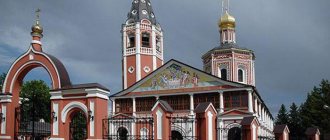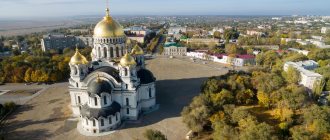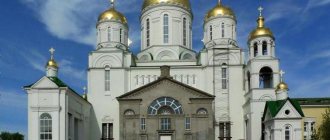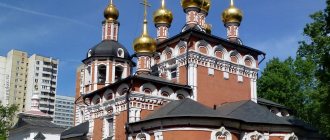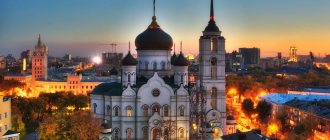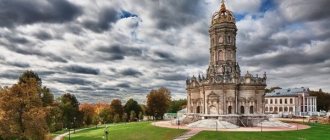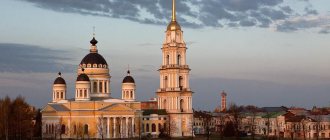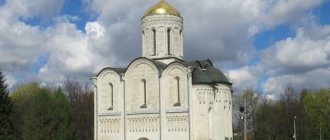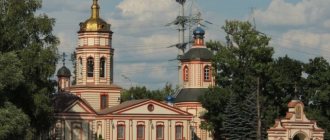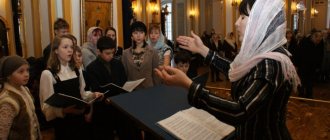One of the historical places on a small hill is occupied by the Nativity Cathedral in Lipetsk. The location of this holy relic is in the area where in ancient times, several decades before the invasion of the Tatar-Mongol yoke, a Slavic settlement was founded, which was protected by steep slopes on the northern and western sides. And only the eastern part, which has a gentle approach to the top of the hill, was once built with a defensive hill, part of which remains to this day.
Description
The Nativity Cathedral in Lipetsk is accidentally considered one of the main attractions of this city, its pride and pearl among many architectural buildings.
The ensemble includes:
- high bell tower;
- main temple;
- refectory.
This church building is rightfully the main cathedral in Lipetsk, which reunites a huge number of believing parishioners and visiting tourists in pilgrimage prayer.
It is interesting to know: the bell tower of the Church of the Nativity of Christ consisted of eight bells, the largest of which weighed more than five thousand pounds.
This grandiose structure was erected over many decades by order of the great Russian ruler Catherine II. Architect - Tomaso Adamani. The construction itself was blessed by one of the Holy Synods - Bishop Innocent of Voronezh.
Without a doubt, you should be fascinated by the article about the 12th century monument - the Church of Boris and Gleb in Kideksha.
Schedule of services at the Nativity of Christ Cathedral in Lipetsk
The temple receives its visitors every day, from Monday to Friday from 07:00 to 18:00. On Saturday the cathedral is open an hour longer, and on Sunday it starts earlier, at 6:00. Divine services are also held daily, with the exception of Mondays. Morning sessions start at 07:30 and evening sessions at 17:00.
You can find out the information you are interested in regarding the work of the temple, as well as find out the time of services on the official page of the Nativity Cathedral on VKontakte, there is no website, or by calling the phone numbers and (4742) 27-04-78.
© Official group of the Nativity Cathedral VK
History of construction
Construction of the stone building began in 1791 and continued until 1803.
The organizers of the construction were P. L. Velyaminov, who did not live to see the consecration of his structure, and N. I. Lodygin. But as soon as the main part of the cathedral was completed, a fire broke out, during which the entire wooden part of the temple burned down, and the stone parts of this structure were also damaged. Construction again had to be resumed from the very beginning.
Thanks to generous donations and the efforts of many parishioners, the Church of the Nativity of Christ was rebuilt by 1805, and the first throne of St. Nicholas the Wonderworker within the walls of this cathedral was consecrated in mid-June of this year, after which regular services began.
The main cathedral was consecrated two years later, in May, by Ioann Panov. The consecration of the third altar throne was performed in 1816 by Archimandrite Anastasius of the Kozlov Trinity Monastery.
Interesting fact: in 1822 it was decided to build a bell tower, the design of which was carried out within the traditional framework. The construction of the bell tower began in 1825, which lasted for 10 years.
After the bell tower was erected according to the project, there was a long break in the construction of the Nativity Cathedral. As soon as the bell tower and the main part of the temple were stabilized, construction began on the refectory part, which was erected in just two years under the strict leadership of Andrei Kalugin. It is known that in 1842 it already began to function for its intended purpose.
It is important to know: from the very moment of its foundation, the cathedral was always considered to have three members, since its clergy always had three of the most respected priests.
As soon as the construction of the refectory part of the temple was completed, the left and right altars of the cathedral were consecrated, and this marked the end of the construction of one of the most important construction projects in the city.
Rules for visiting the cathedral
Before visiting the temple, you must turn off the sound on your mobile phone or come without it at all. Talking on the phone during the service or being distracted by messages is also not recommended.
Before attending services, it is advisable to read the Bible or Gospel and tune in to prayer. It is necessary to analyze your life and behavior, think through the sins that can be expressed in confession. It is also worth remembering the good moments - everything for which you can thank the Lord during prayer.
Clothing should be modest and clean, the same goes for shoes. A person’s appearance affects his inner state, and vice versa - clean and tidy clothes reflect pure and modest thoughts. Calmness and tranquility should be personified in all appearance. On holidays it is better to choose light clothes, and on days of mourning - dark ones.
Women must come to the temple in skirts below the knee and with their heads covered. Men must always bare their heads in the temple. Shorts are not permitted for men or children over 7 years of age.
When entering the church, you need to cross yourself three times and you can read the prayer “Our Father” or simply say “Lord have mercy.” During prayer and the signs of the cross, you should turn your gaze to the vault of the temple.
You should come to the service on time or early, do not smoke near the temple, and do not talk about personal matters and problems. Silence and reverence should reign in your thoughts. Prayer should be done silently or in a whisper, as well as with singing. You cannot leave the temple during the service; it is better to wait until it ends. During the service, you should also not walk around the temple, light candles or talk.
Fate during the revolution and Soviet times
In pre-revolutionary times, the Church of the Nativity of Christ was considered the central part of Lipetsk, as well as the main attraction that attracted all city guests, tourists and relatives.
But, unfortunately, despite all its historical and cultural value, the Nativity Cathedral after the revolutionary movement in 1917 became just one of many Orthodox relics that were considered by the new government as an accessible source of rich profit.
On February 23, 1922, the authorities approved a secret protocol with a resolution on a complete inspection and inventory of church property in all Orthodox churches in Lipetsk. The main goal of the authorities was aimed at compiling an accurate report on the existing church utensils made of gold and silver. After which the authorities, having invented a non-existent “time of famine”, announced donations to help the hungry and began to confiscate all church valuables.
According to a decree from Moscow dated March 14, 1922, the executive committee began to form a special commission to confiscate church valuables.
Take note: they decided to begin the seizure precisely from the Church of the Nativity of Christ, since it was considered one of the richest Orthodox buildings.
The commission of the executive committee began to carry out its work on March 16, 1922, but was met with protest from 200 people - caring people and believing parishioners of this cathedral, who considered all the members of this commission to be antichrists and traitors to the Almighty.
The commission members retreated and attempted to put pressure on clergyman Suvorov and members of the church council in order to induce them to voluntarily cooperate. But their attempts were in vain. After this, the authorities sent a detachment of Red Army soldiers to help, who used force to requisition the cathedral.
Subsequently, the “people's power” approved a campaign to close the temple in 1931. Throughout this entire time, members of the Lipetsk City Council were preparing to close the temple to believers and services. At the same time, the very top of the government was thinking about what purposes to use the church building taken from the Orthodox people.
The initial idea of the authorities to use the temple building was aimed at housing workers there, but after calculating all the necessary investments for the required reconstruction, the authorities decided to use the building to create a theater in it. But the theater was never created, but a storage facility for grain and vegetable crops was made. In the refectory part of the cathedral there was a museum of local history. But the believing people did not lose hope and continued to fight for the restoration of the temple and the return of their rights.
Please note: the temple was returned to the Orthodox people for full use and holding of sacred services in 1991.
And finally, by the will of the Almighty, persons appeared who had their influence in the upper circles and were interested in restoring the Orthodox Nativity Cathedral. Repair work and restoration of the temple was carried out by L.E. Rudakov, this happened between 1957 and 1958.
Current state
Currently, the cathedral fits quite organically into the overall plan of architectural development of the main square of Lipetsk.
This temple is one of the most interesting and beautiful features and attractions of the city. It attracts with the integrity of its structure from an architectural point of view. All components of the ensemble form a single whole:
- the church itself;
- Bell tower;
- refectory.
It is important to know: thanks to its unusual location at the very top of the hill, the Cathedral of the Nativity can be seen from any part of the city.
The composition of the temple is thought out and executed with extraordinary simplicity, conciseness, restraint and clarity.
Architectural features
The style of the modern structure of the Orthodox building is classic with an original 2-tier volumetric composition. The apse with a semicircular shape adjoins the first square two-story tier of the temple, and around there are three aisles of the same rectangular shape.
The temple itself is topped with a gilded vast dome, which recreates the majesty of this structure, despite its simplicity in the stylistic design of the building.
The facades on the northern and southern sides, belonging to the first tier, are topped with loggias with extraordinary columns. Exactly in the middle between the columns there are doors of a double-leaf structure, above which there is a semi-circular window with a second degree of illumination.
This is interesting: among other things, the temple has two porches located on the north and south sides.
Moreover, the cathedral has several chapels:
- Chapel of St. Nicholas the Wonderworker
- Chapel of Seraphim of Sarov;
- Cross-Exaltation chapel;
- Chapel of the Smolensk Icon of the Mother of God.
All other delights of this building can be appreciated during sacred services or during holy holidays, when, for example, during the service for Christmas or Epiphany, the main part of the population of Lipetsk gathers in the temple.
Patronal holidays[edit]
Nativity
- Jan. 7
Exaltation of the Life-Giving Cross of the Lord
- September 27
Nicholas the Wonderworker, Archbishop of Myra, Saint
— May 22, December 19
Seraphim of Sarov, Rev.
— January 15, August 1
Icon of the Blessed Virgin Mary "Hodegetria" Smolensk
- (10th of August)
Interior decoration
The decorations in the interior of the structure were purchased with donations from people collected over several generations. After which the decoration of the temple was gradually replenished with the most beautiful paintings and icons of Lipetsk gifted artists.
Interesting fact : now, thanks to Archpriest Bilchuk, the temple has been completely restored. It houses a huge number of magnificent icons, and at the beginning of 2001 the relics of 82 holy Kyiv Pechersk ascetics were transported here.
After the revolution, the temple was one of the richest and most unusually beautiful cathedrals. But in 1931 it was completely plundered by the people's authorities.
Cathedral Mentors
Each rector of the cathedral was a respected person in the city, especially in history the name of Archpriest A.V. Suvorov, who was with the cathedral during the difficult post-revolutionary time for it.
They tried to force him to cooperate during the theft of temple property, but he persistently fought back the raiders. He was arrested several times and sent to prison, including for counter-revolutionary agitation.
Today the following services are performed in the temple:
- rector Archpriest V.A. Bilchuk;
- sergeant archpriest V.R. Maksimchuk;
- Archpriest A.Yu. Proboscis;
- Priest V.V. Arkhipkin;
- Priest S.V. Grishanov;
- Deacon A.V. Aleshin;
- Deacon O.Yu. Maltsev.
Over the many years of the cathedral's existence, the clergy carried out their service with honor and protected the honor and shrines of the cathedral.
History of the cathedral bell tower
The decision to build this structure was made in 1825. The construction of the bell tower in a strict classical style was planned. The construction was finally completed only 10 years later.
Good to know : of the eight bells placed on the bell tower, one weighed 489 pounds, which was only recast in 1900, after which it began to weigh 558 pounds 10 pounds, which is approximately equal to 9 tons.
Such a long time for the construction of part of the temple complex was spent on the construction of its five tiers, decorated with various shapes, porticoes, arches and other architectural decoration elements. The total height of the entire bell tower is about 90 arshins.
History of the tower clock
The very first clocks were installed in the mid-nineteenth century. After serving for about half a century, they broke.
At the end of 1970, at a height of 30 meters in the bell tower, it was decided to install a new tower clock with musical performance. Lipetsk chimes were launched in December of this year.
The tower clock mechanism itself was produced by the Petrodvorets Clock Factory. The design of the dial was developed by the indigenous resident V. I. Neminushchiy.
Interesting Facts
The sacred icon of the Passionate Lipetsk Mother of God located here is a true city relic. When in 1831 the population of Lipetsk was attacked by the terrible disease cholera, people began to die in dozens, all residents of the city in kneeling prayer asked the Most Holy Theotokos for salvation and deliverance from this terrible curse.
The clergy made a crusade with the icon. For two days the Lipetsk residents fasted and prayed for deliverance from the epidemic, and a real miracle happened. Cholera disappeared without a trace.
Lipchan residents remembered this healing for centuries. Nowadays, as almost two hundred years ago, the icon helps believers to be healed of terrible illnesses.
Shrines[edit]
Icon of the Mother of God “Lipetsk” (“Passionate”)
- an ancient copy of the icon of the Passionate Mother of God, revered as miraculous, is located in the Nativity of Christ Cathedral in Lipetsk and in the Church of the Nativity in Lipetsk. In honor of this icon, a chapel was built in the Lipetsk Cathedral. The locally revered image of the Lipetsk diocese, the celebration of the icon takes place on August 13 (26) (on the day of the celebration of the Passion Icon). This miraculous image is considered the main shrine of Lipetsk.
The icon, according to legend, is of ancient origin; numerous healings are attributed to it. In 1831, severe cholera raged in Lipetsk and its district. At this time, many Lipetsk residents remembered the miraculous icon of the Mother of God. The passionate icon was taken out of the church, carried through the city with a procession of the cross and taken from house to house. According to legend, the mortality rate from cholera decreased after this, and the epidemic soon stopped.
In 1833, on the proposal of Tambov Bishop Arseny, the Holy Synod officially established a procession of the cross, taking place from the cathedral with a large gathering of people, icons and banners from other city churches. Grateful Lipetsk residents eventually decorated the miraculous icon with a silver robe weighing 20 pounds 65 spools and many precious stones. Unlike the usual image, on the Lipetsk Icon of the Mother of God “Passionate” the instruments of the Lord’s Passion are depicted in an enlarged form at the bottom of the image, and the cross is diagonally behind the back of the Mother of God, depicted without the Infant God.
Photo gallery
[Show slideshow]

